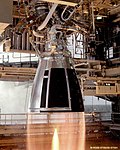Miranda (engine)
An editor has nominated this article for deletion. You are welcome to participate in the deletion discussion, which will decide whether or not to retain it. |
| Country of origin | |
|---|---|
| Date | 2022 |
| Designer | Firefly Aerospace |
| Manufacturer | Firefly Aerospace |
| Application | Main engine |
| Associated LV | Antares 330 MLV |
| Predecessor | Reaver |
| Status | In development |
| Liquid-fuel engine | |
| Propellant | LOX / RP-1 |
| Cycle | Combustion tap-off |
| Pumps | Turbopump |
| Configuration | |
| Chamber | 1 |
| Performance | |
| Thrust, vacuum | 1,023 kN (230,000 lbf) |
| Specific impulse, vacuum | 305 s (2.99 km/s) |
| References | |
| References | [1] [2] |
| Notes | engine is reusable on MLV vehicle |
Miranda is a liquid-fueled rocket engine currently being developed by Firefly Aerospace to power the company’s MLV (Medium Launch Vehicle). It will also be used on the Antares 330 rocket developed by Northrop Grumman.[3]
The Antares previously used a Ukrainian-built first stage with the Russian-built RD-181 engine and production ceased after the Russian invasion of Ukraine.[4] Firefly will also assemble the entire first stage for the Antares 330.[5]
Development began in 2022 and in 2024 Firefly reported substantial progress on testing the engine, with 20 test fires completed. As of June 2024, the Miranda engine had entered production.[5]
Firefly said that it has designed the Miranda from its inception for reusability. The company plans to restart the engine multiple times as the rocket performs a return-to-launch-site maneuver for a propulsive landing.[5]
See also
[edit]References
[edit]- ^ "New Medium Launch Vehicle". Firefly Aerospace. Retrieved 16 August 2024.
- ^ "Northrop Grumman Teams with Firefly Aerospace to Develop Antares Rocket Upgrade and New Medium Launch Vehicle". Firefly Aerospace. 17 August 2022.
- ^ Foust, Jeff (8 August 2022). "Northrop Grumman and Firefly to partner on upgraded Antares". SpaceNews. Retrieved 22 June 2024.
- ^ Tingley, Brett (29 November 2023). "Firefly Aerospace's new rocket engine spouts green flames in 1st 'hot fire' test (photo)". Space.com. Retrieved 22 June 2024.
- ^ a b c Clark, Stephen (2 July 2024). "Firefly is building fast and breaking things on path to a reusable rocket". Ars Technica. Retrieved 9 September 2024.

